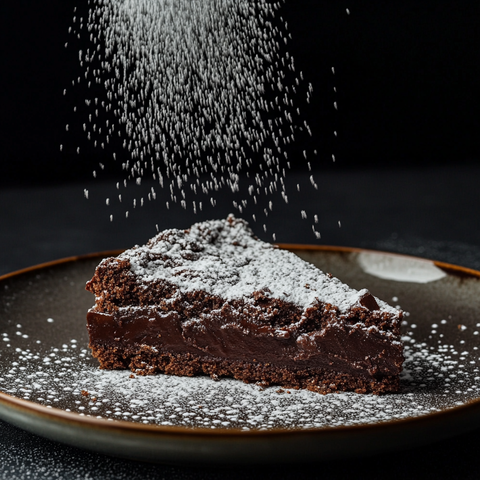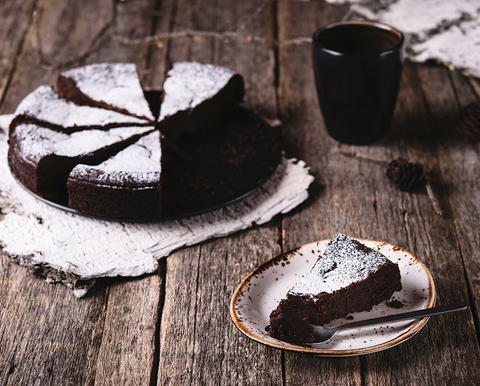We are on Trustpilot
We are rated Excellent, read what our customers are saying

Why Kladdkaka Deserves Its Own Day: A Swedish Fika Favorite
Once upon a time in Swedish kitchens, a culinary accident gave birth to one of the nation’s most beloved desserts. Kladdkaka, meaning “sticky cake,” likely emerged during the scarcity of World War II when baking powder was hard to come by. A forgetful baker may have left it out, pulling a cake from the oven that didn’t rise but instead developed a gooey, molten center. This serendipitous mistake was an instant hit, and over the decades, kladdkaka transformed from a simple home recipe into a cultural icon, celebrated every year on Kladdkakans dag.
This sticky chocolate cake is not just a treat; it’s a cornerstone of fika, Sweden’s cherished coffee break ritual that revolves around slowing down, connecting with others, and indulging in small pleasures. Whether served warm with a scoop of vanilla ice cream or dusted with powdered sugar, kladdkaka represents the joy of gathering, reflecting Sweden’s deep-seated love for community and comfort food.

On Kladdkakans dag, Swedes across the country bake and share this dessert, often recounting kitchen mishaps that are as much a part of the tradition as the cake itself. Stories abound of cakes too gooey to slice or baked so enthusiastically that batter spills over the oven, only to result in delicious, imperfect masterpieces. These mishaps remind everyone that in the world of kladdkaka, imperfection is not just accepted—it’s celebrated.
Whether experimenting with bold twists like chili and licorice or sticking to the classic recipe, kladdkaka offers a slice of Swedish culture that’s both rich in flavor and history. It’s a dessert that unites generations, embodies the spirit of fika, and proves that sometimes, the best things in life come from happy accidents!
One of the reasons why kladdkakan has become so popular and won the hearts of the Swedish people is probably because there are so few ingredients involved and that the procedure is so simple. Almost anyone can put together a good kladdkaka. The ingredients are also ones that most people have at home, which means that you can throw together a kladdkaka at short notice. All you need is: 150 g butter, 3 eggs, 3 dl sugar, 3.5 dl wheat flour, 1 dl cocoa, 1 tbsp vanilla sugar and a little bit of salt.
1. Line the bottom of a mold, approximately 22 cm in diameter, with baking paper.
2. Melt the butter.
3. Whisk the eggs and sugar together lightly and stir in the butter.
4. Mix flour, cocoa, vanilla sugar and salt and stir into the egg mixture.
5. Pour the batter into the mold and bake the cake in the lower part of the oven at 200 degrees for about 12 minutes. Remove the cake from the mold and enjoy it freshly baked and warm with lightly whipped cream or ice cream, or store it at room temperature or in the refrigerator until ready to serve.

Kladdkaka Unknown Facts:
The Cake That Doesn’t Rise: Unlike most cakes, kladdkaka is made without any leavening agent, resulting in its unique dense and gooey texture. This absence of baking powder or soda sets it apart from brownies or sponge cakes.
Historical Influence: Some food historians believe that kladdkaka may have been influenced by French chocolate desserts, as Swedish food writer Margareta Wickman is thought to have introduced a similar recipe after a trip to Paris in the 1970s.
IKEA’s Secret Weapon: Although kladdkaka is a staple in Swedish homes, it gained international fame through IKEA, which serves its own version in cafes worldwide, introducing this Swedish treat to millions
It’s a Kid-Friendly Dessert: Kladdkaka is often one of the first desserts Swedish children learn to bake because it’s easy, quick, and forgiving. Even if it’s a bit undercooked, it still tastes amazing.
A Regional Favorite: While kladdkaka is loved throughout Sweden, certain regions add their own twist. For example, in Gothenburg, some recipes call for salty licorice as a topping, adding a uniquely Swedish flavor.
Cold Weather Dessert: Swedes often enjoy kladdkaka during colder months. It pairs perfectly with a hot cup of coffee, making it a warming and comforting treat during long Nordic winters.